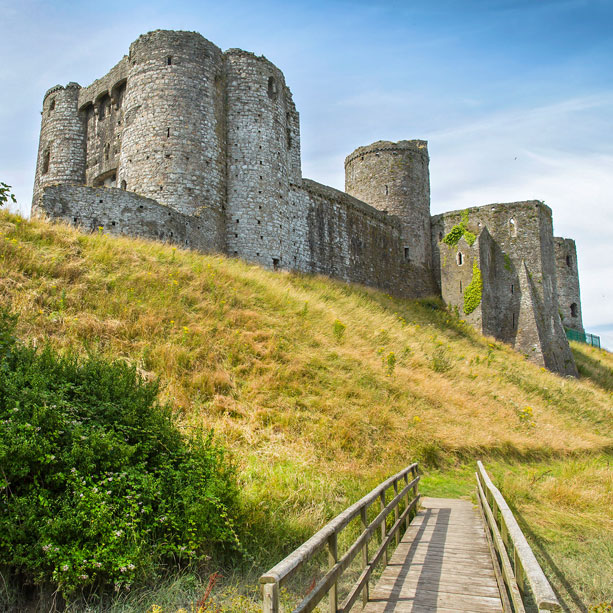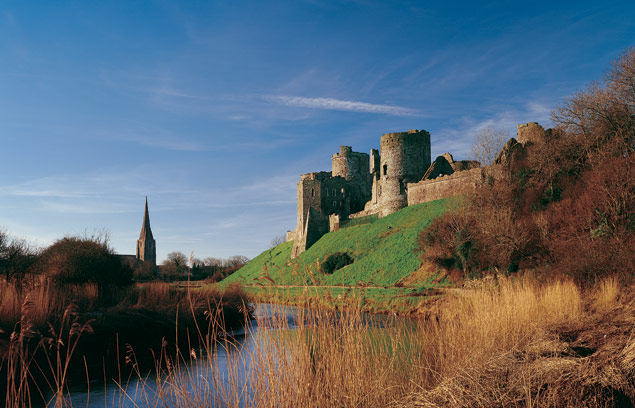Perched majestically above the River Gwendraeth, Kidwelly Castle (Welsh: Castell Cydweli) stands as a testament to the rich and tumultuous history of Wales. Located in the town of Kidwelly, Carmarthenshire, this Norman castle has witnessed centuries of conflict, rebellion, and legend, making it one of Wales’ most fascinating historical sites.

Early History: Foundations of Power
The origins of Kidwelly Castle trace back to the early 12th century when Roger, Bishop of Salisbury, was entrusted as the lord of Kidwelly. Soon after, the construction of the castle and the adjoining town began. The fortress was strategically built as a defense against the native Welsh, who were fiercely protective of their lands.

History and Architecture: A Castle Shaped by Conflict
The present remains of Kidwelly Castle date from the early 12th century, although the castle itself has undergone numerous transformations due to the many conflicts it has endured. Throughout the 12th century, the castle frequently changed hands between the Normans and the Welsh. In 1159, the Welsh Prince Lord Rhys captured Kidwelly Castle and was later recognized by King Henry II of England as the ruler of the region. However, after Lord Rhys’ death, the castle returned to Anglo-Norman control.
One of the castle’s most significant episodes occurred in 1231 when it was captured and razed by Llywelyn the Great, one of the most powerful Welsh rulers of the time. Despite its strong defenses, Kidwelly Castle continued to face threats, including an unsuccessful siege by forces of the Welsh hero Owain Glyndŵr in August 1403. With the aid of soldiers from France and Brittany, Glyndŵr’s forces captured the town of Kidwelly, but a Norman army relieved the castle in September of the same year.

Architecturally, Kidwelly Castle is a prime example of a medieval stronghold. Its design features a square inner bailey defended by four round towers, which overlook a semi-circular outer curtain wall on the landward side. The massive gatehouse stands next to the river, a key element of the castle’s defense. Although the river prevents the castle from having a true concentric plan, a jutting tower protects the riverside walls, creating a formidable fortress. One unique feature of Kidwelly Castle is the stair built against the outer curtain wall from the level of the ward, a rare architectural detail for English castles of that era.
Despite the many conflicts it has faced, Kidwelly Castle remains relatively well-preserved. Today, it is managed by Cadw, the historic environment service of the Welsh Government, and continues to be a popular destination for visitors interested in Welsh history.

Legends and Ghosts: The Haunting of Gwenllian ferch Gruffydd
The history of Kidwelly Castle is also intertwined with Welsh legend. The surrounding countryside is reputedly haunted by the headless ghost of Gwenllian ferch Gruffydd, the wife of the Welsh prince Gruffydd ap Rhys. In 1136, Gwenllian led a heroic but ill-fated rebellion against the Normans. She was captured and beheaded, and her spirit is said to roam the area, a tragic reminder of the castle’s violent past.
Kidwelly in Film: A Cinematic Legacy
Kidwelly Castle’s dramatic appearance has also caught the attention of filmmakers. The castle was used as a location for the iconic 1975 film Monty Python and the Holy Grail. It appears in the very first scene after the opening titles, adding a touch of historical authenticity to the comedy classic.

Conclusion
Kidwelly Castle is more than just a medieval fortress; it is a symbol of the enduring struggle between the Welsh and the Normans, a repository of legends, and a picturesque backdrop for cinematic history. Whether you are drawn by its historical significance, its architectural beauty, or its ghostly tales, Kidwelly Castle offers a captivating glimpse into the past of Wales.

